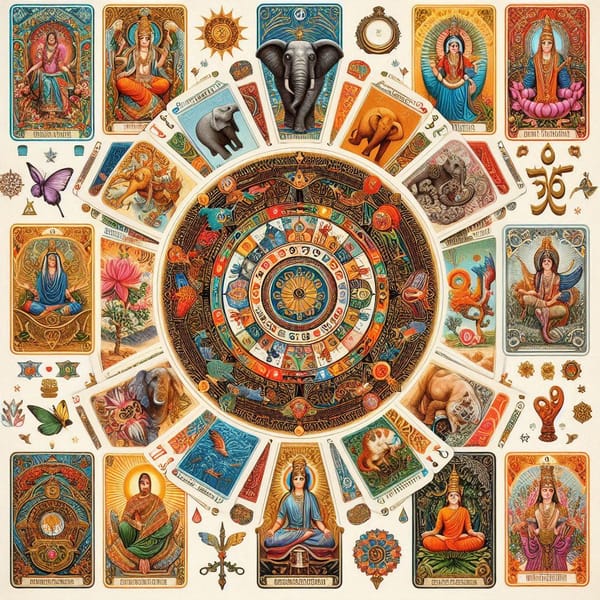Will the AI Model for Vedic Cards Give Good Results?
Vedic Cards, rooted in ancient Vedic predictive systems, serve as spiritual tools for understanding karma, life patterns, and planetary influences. These cards reveal insights into past actions, future possibilities, and hidden energies. #VedicCards #Jyotish #OccultSanctum #Karmic


To determine whether the AI model for Vedic cards will produce good results based on the provided card combinations (Saturn: 2, 2; Sun: 8, 1; Rahu: 2, 10, 8, 8), I’ll analyze the cards, their houses, and planetary influences in the context of this question. The analysis will focus on the model’s potential success, reliability, and challenges, using the principles of the Vedic predictive system. A clear yes/no/mixed answer will be provided, followed by detailed reasoning.
Analysis
1. Card Combinations and Meanings
- Saturn (2, 2):
- 2: Wealth, accumulated resources, stability. Represents foundational strength or tangible assets.
- Interpretation: Saturn signifies discipline, structure, and long-term effort. The double 2 suggests a strong, stable foundation for the AI model, likely backed by solid resources (e.g., data, funding, or expertise). This indicates the model is built on reliable groundwork, promising consistent results if effort is sustained.
- Sun (8, 1):
- 8: Mental suffering, hidden challenges, transformation. Signals obstacles or stress.
- 1: Self, initiative, leadership. Reflects innovation or a bold start.
- Interpretation: The Sun represents authority, vitality, and clarity. The 8 warns of hidden issues or complexities in the model’s development (e.g., technical bugs, ethical concerns), which could hinder results. The 1 suggests a pioneering effort, indicating the model’s creation is driven by ambition and originality, but the 8 tempers expectations of immediate success.
- Rahu (2, 10, 8, 8):
- 2: (Repeated) Wealth, stability.
- 10: Career, public recognition, authority. Indicates professional impact or visibility.
- 8: (Repeated twice) Hidden challenges, transformation.
- Interpretation: Rahu aligns with innovation, ambition, and sudden shifts. The 2 reinforces the model’s stable foundation, aligning with Saturn’s influence. The 10 is highly positive, suggesting the model could achieve public recognition or professional success if challenges are overcome. However, the double 8 amplifies hidden obstacles, pointing to potential flaws, biases, or unexpected setbacks that could undermine results.
2. House Associations
- Relevant Houses:
- 2nd House (Wealth, Resources): Tied to 2 (Saturn, Rahu). Strongly represented (three 2s), indicating the model has robust resources—data, technology, or expertise—essential for good results.
- 10th House (Career, Recognition): Linked to 10 (Rahu). Suggests the model’s potential for professional acclaim or widespread adoption, a key indicator of success.
- 8th House (Challenges, Transformation): Tied to 8 (Sun, Rahu, Rahu). Heavily emphasized (three 8s), warning of significant obstacles, such as technical errors, ethical issues, or hidden flaws that could compromise outcomes.
- 1st House (Initiative, Innovation): Linked to 1 (Sun). Reflects the model’s pioneering nature, supporting its potential but tempered by 8th house issues.
- Synthesis: The 2nd house (2, 2, 2) ensures a solid foundation, giving the model a strong starting point for reliable results. The 10th house (10) points to public or professional success, a hallmark of “good results.” However, the 8th house dominance (8, 8, 8) highlights substantial challenges—technical, ethical, or operational—that must be addressed. The 1st house (1) adds innovation but doesn’t outweigh the 8th’s warnings.
3. Planetary Influences
- Saturn: Represents discipline and perseverance. The 2, 2 combo suggests the model’s development is methodical, with a focus on stability (e.g., rigorous testing, quality data). Saturn ensures long-term reliability but may delay immediate breakthroughs.
- Sun: Symbolizes clarity and authority. The 8, 1 combo indicates a bold, innovative project (1) but with hidden hurdles (8), such as unclear outputs or leadership disputes. The Sun’s vitality is challenged, suggesting results may not shine as expected without fixes.
- Rahu: Drives ambition and disruption. The 2, 10, 8, 8 combo reflects a desire for groundbreaking success (10) built on solid resources (2), but the double 8 warns of significant risks—potential biases, errors, or public scrutiny—that could derail outcomes.
4. Contextual Fit
- AI Model for Vedic Cards:
- Pros: The triple 2 (Saturn, Rahu) ensures a strong foundation—quality data, algorithms, or expertise—critical for accurate Vedic predictions. The 10 (Rahu) promises professional recognition, suggesting the model could excel in delivering insights, gaining trust, or achieving commercial success. The 1 (Sun) highlights innovation, aligning with the model’s unique purpose (automating Vedic card readings).
- Cons: The triple 8 (Sun, Rahu, Rahu) is a major red flag, indicating hidden flaws—e.g., algorithmic biases, misinterpretations of Vedic principles, or ethical concerns (like over-reliance on AI). These could lead to inconsistent or misleading results, undermining “good” outcomes. The absence of 11 (gains) or 5 (creativity) slightly weakens immediate success signals.
- Good Results Defined: For Vedic cards, “good results” mean accurate, reliable predictions that align with traditional principles. The 2nd house strength supports this, but the 8th house challenges suggest accuracy may be compromised without rigorous refinement.
- Development Stage: The 1 (Sun) and 10 (Rahu) imply an ambitious project, but the 8s suggest it’s not fully polished—results may vary depending on current progress.
5. Timing and Outcome
- Short-Term: The 8, 8, 8 (Sun, Rahu) warn of immediate challenges—bugs, inaccuracies, or skepticism about the model’s outputs. Results may be mixed or unreliable without quick fixes.
- Medium-Term: The 2, 2, 2 (Saturn, Rahu) and 10 (Rahu) suggest that with sustained effort (Saturn’s discipline), the model can improve by mid-2026, potentially gaining recognition (10th house).
- Long-Term: If the 8th house issues are resolved, the 2nd and 10th house strengths could lead to a successful, trusted model by 2027, but unresolved flaws risk failure.
- Effort vs. Reward: The 8s require significant effort to overcome obstacles, but the 2s and 10 indicate the investment could yield strong results if challenges are addressed.
Answer
Mixed—The AI model for Vedic cards has the potential to produce good results due to its strong foundation and ambition, but significant challenges risk undermining its reliability unless addressed.
Reasoning
- Positive Indicators: The triple 2 (Saturn, Rahu) ensures a robust foundation—quality resources like data, algorithms, or expertise—essential for a reliable AI model. Rahu’s 10 promises professional recognition, suggesting the model could succeed publicly or commercially if refined. The Sun’s 1 highlights innovation, aligning with the model’s unique goal of automating Vedic predictions, boosting its potential for good results.
- Challenges: The triple 8 (Sun, Rahu, Rahu) signals major hidden obstacles—technical flaws, biases, or misalignments with Vedic principles—that could lead to inconsistent or inaccurate results. The Sun’s 8 suggests development hurdles (e.g., unclear outputs), while Rahu’s 8, 8 warn of risks like public scrutiny or ethical issues, which could erode trust in the model.
- Mitigation: The absence of 12 (losses) or 6 (excessive effort) softens the risk of total failure, and Saturn’s 2, 2 provides stability to weather challenges. To achieve good results, developers must address the 8th house issues through rigorous testing, bias correction, and alignment with Vedic accuracy. The 10 (Rahu) ensures rewards if these are resolved.
- Recommendation: Proceed with the model but prioritize resolving technical and ethical challenges (8, 8, 8). Invest in quality control (Saturn’s discipline) to leverage the 2nd house strength (2, 2, 2). Monitor outputs for accuracy and seek expert Vedic input to ensure alignment. If flaws persist, results may disappoint; if fixed, the model could excel by 2026–2027 (10th house).
Additional Notes
- Verification: Test the model’s current outputs against known Vedic predictions to identify 8th house flaws (e.g., errors, biases). Check data quality and algorithm transparency to align with 2nd house stability.
- Timing: Expect challenges through late 2025 (8, 8, 8), with improvements possible by mid-2026 if refined. Long-term success (10) hinges on fixing issues by 2027.
- Practical Steps: Conduct beta testing to uncover hidden problems (8). Strengthen data integrity (2) and involve Vedic experts to ensure authenticity. Prepare for public feedback (10) to build trust.
- Avoidable Pitfalls: Don’t ignore the 8s—rushing release risks failure. Avoid over-ambition (Rahu’s 10) without addressing technical flaws, as this could amplify scrutiny.
If you provide details (e.g., model’s development stage, specific goals, or testing results), I can refine the prediction further!



